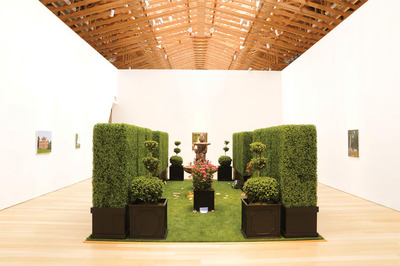Karen Kilimnik
The Brant Foundation Art Study Center • Greenwich, CT • www.brantfoundation.org • Through August, 2012

Karen Kilimnik, Fountain of Youth, 2012
About once a year, the Brant Foundation Art Study Center hosts an exhibition of works primarily owned by its founder, the billionaire industrialist Peter Brant. The collector owns more than eighty works by artist Karen Kilimnik, and in May he opened his foundation for appointment-only visits to see a three-decade sampling of about sixty of her works that he and the artist selected.
Kilimnik sources much of her work from either the reverie of wealth in eighteenth century Europe or imagery from teen fan paraphernalia, but whether it’s a handsome aristocrat in The Major Lieutenant (2007), a manor house in the devils dining room (2011), or Leonardo DiCaprio in Prince Albrecht (1998), the work is still the subject of youthful fancy.
Though the Kilimnik show isn’t the Brant’s first, it seems like the 9,800 square-foot renovated barn on the edge of a polo field and at the end of a snaky, gated driveway in Greenwich was conceived for the exhibition. The work subsumes much of the space and, moreover, the building’s idyllic country setting becomes tangibly linked with the luxurious mis-en-scènes that embellish so many of Kilimnik’s works.
Kilimnik created a tent, shrines, and rooms within rooms to hang her work, but she also takes over entire galleries. In Fountain of Youth (2012), a seamless, live hedgerow surrounds a bubbling fountain. The entire space takes on the guise of both the paintings and the estate over which the Brant looms.
These strong moments are unfortunately sold short by a level of organization that at times seems as scattered as Kilimnik’s early installation works. This is a show that wasn’t curated with professional distance; it’s an overt celebration of a collection. A few red-hued abstract landscapes created this year are another reminder of these shortcomings. The works are glossy photographs with glitter, and though lighthearted, they aren’t much without the shimmer of their materials. They haven’t been vetted by the noncommercial organs of the art world. From critics, to museum curators, to walk-in gallery visitors, no one has seen these works outside of Brant’s barn. The show is also devoid of any educational literature except for a press release that touts the show as “museum-scale,” but it is instead the scale of one prolific collector.
—Christian Holland
